Made By:
Mega House
Scale:
1/24
MSRP:
¥27,280
| Overview: | |
|---|---|
| Packaging (Design): | 10/10 |
| Packaging (Durability): | 10/10 |
| Casting (Body): | 9/10 |
| Casting (Interior): | 10/10 |
| Casting (Chassis): | 10/10 |
| Casting (Engine): | N/A |
| Paint (Exterior): | 10/10 |
| Paint (Interior): | N/A |
| Paint (Trim/Graphics): | 10/10 |
| Overall Panel Fit: | 9/10 |
| Total Score: | 9.8/10 |

Other Comic & Manga Models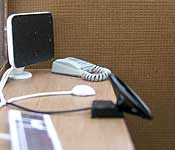
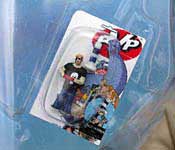
Teen Titans #9 Batmobile
Pearls Before Swine Revenge-O-Mobile
The Circuit Wolf Lotus Europa
Evangelion Renault Alpine A310
Zessyaka! Subaru 360 Deluxe
Batman #408 Batmobile
Ctrl-Alt-Del Zeke
DC Bombshells Supergirl (Review)
Lupin III Mercedes-Benz SSK (Review)
Detective Comics #800 Batmobile
DC Bombshells Catwoman (Review)
Detective Comics #377 Batmobile
Misery Machine
Cyber Formula Experion Z/A-8 (Review)
PvP Dexter Jettster
Cyber Formula SIN Ogre AN-21 (Review)
Judge Parker Corvette
DC Bombshells Harley Quinn (Review)
Transformers G1 Prowl
Other Cartoon & Anime Models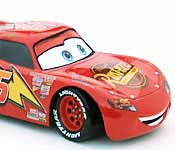
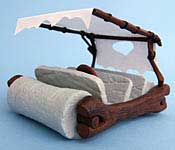
Ghost in the Shell Motoko Kusanagi
Planes 2 Firefighter Dusty (Review)
Betty Boop ‘39 Chevy Deluxe (Review)
My Neighbor Totoro Catbus (Review)
F&F: Spy Racers Crawler (Review)
Vifam Twinklehead
Rick and Morty Space Cruiser
Thundercats Thundertank (Review)
Cars 3 Cruz Ramirez
Rugrats Movie Reptar Wagon (Review)
Evangelion Renault Alpine A310
Hello Kitty Skyline GT-R (Review)
Thundercats Cheetara
Zootopia Police Cruiser (Review)
Cars Lightning McQueen
Roadster Racers Minnie (Review)
The Simpsons Canyonero
1992 Batman:TAS Batmobile
WALL·E
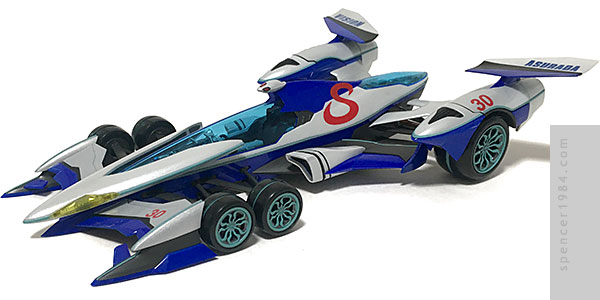
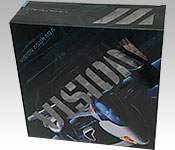
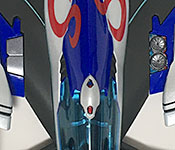
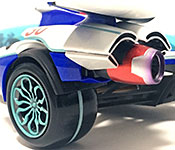
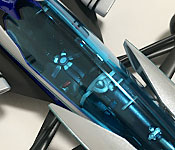
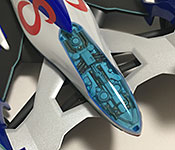
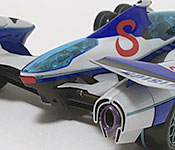
Background
In commemoration of the 30th anniversary of Future GPX Cyber Formula, machine designer Shoji Kawamori created an all new Asurada called the Vision Asurada. Along with designing the vehicles used in Cyber Formula, Kawamori's work includes creating mechs for the Macross series, Crusher Joe, Space Battleship Yamato, The Vision of Escaflowne, Patlabor, Ghost in the Shell, Armored Core, and several Diaclone designs that would go on to become the Transformers characters Prowl, Ratchet, and Optimus Prime.
Packaging
The box is the same size as the previous Cyber Formula boxes, and the interior tray design is essentially the same as before, but this is a whole new take for the outer box. It now sports a black background with a single large wireframe schematic of the racer, the car name/number, and several fine laser lines all done in electric blue. A large full-color graphic of the car is in one corner of the main panel (and wraps around to the two adjacent panels), with a high gloss sheen over the image to further contrast with the matte black of the rest of the box. Several product photos have been arranged on one of the remaining side panels, and the last side panel continues the wireframe and repeats the name/number. "VISION" is knocked out diagonally across the main panel, with clear plastic on the inside of the box to create a unique window to see the car. Three angled boxes on opposite side panels, also backed with clear plastic, let you see the front and rear of the car. The main back panel has four drawings of the car: one large on centered near the top, and three smaller ones underneath showing Boost Mode, Circuit Mode, and Aero Mode. The requisite legal information is just below these three pics. Inside is a folded insert finished in mirror chrome with the same large drawing from the back of the box and two more repeats of the car's name & number. As with previous releases from Mega House, the car is sandwiched between two molded plastic trays with the accessories in separate compartments and soft plastic sheeting to protect the paint. The whole thing feels very premium, which you'd hope for at this price.
Casting/Paint
Whenever I encounter a mass-produced item - no matter how limited, no matter how intricate - there's always a certain feeling of manufacturing to it. This is as close as I've gotten to something that feels like a model kit. The bottom of the chassis is diecast and the rest of the model is plastic, just like previous Cyber Formula cars, but this one feels much more delicate. That sensation is somewhat justified: in swapping out one of the waist pods, the blue trim became detached from the intake and had to be re-glued. It was a simple fix and not something I counted against it since I was the one pulling on it at the time, but it does go towards proving how incredibly delicate this can be.
The quality of the work here is nothing surprising given their previous releases. Edges are sharp, panels are smooth, and everything fits together just as good as you'd hope a futuristic racing machine would be. The main body is layer after layer of sculpted detail: tiny canards inboard of the forward mandibles; separate aerodynamic suspension components; clear lenses on the dual headlights and single taillight; tiny ports tucked into the rear diffuser; delicate gridwork on the rear intakes. There's so much to see here even before you get into the alternate parts.
Also of note are the wheels, all six of which are open spoked to allow you to see the fixed brake calipers inside. Underneath, the chassis is a smooth contour with just a few panel lines to suggest maintenance access. The cockpit and rear are enclosed by transparent blue canopies, allowing you to see the various mechanical and technical details. The cockpit is particularly impressive, with separate belts, controls, computer interface, and more. It's an impressive amount of greebling for something that could have been done with a single color over some random bumps.
Speaking of color: the paint. The base color is a pearlescent silver with the leading edges of the aero surfaces done in a dark royal blue. The chassis, suspension, steering arms, wheel backs, underside of the front wing, and interior waist wings are done in a dark gray that looks black until you see them next to the true black of the tires. Black is also used for the rear inlets and some striping on the fore and aft wings. The same electric blue from the packaging is used for pinstriping and the wheel spokes. Metallic copper is used for the drive axle and calipers, while silver is used for the rotors and booster tips. The tips are further accented with metallic red at their base and heat discoloration at the openings, fading to black inside. Even the tiny sensor above the main canopy - no more than 6mm across at its widest point - has multiple paint apps to pick out the individual lenses.
The number 30 is printed in red on the front left wing and both boost pods, and the Sugo "S" is printed on the cowling behind the cockpit. Even though the bottom half of each letter is on silver and the top is on blue, Mega House used a print opaque enough to ensure little to no color shift in the red. "VISION" and "ASURADA" are printed in blue on the rear wings, matching the blue used elsewhere. AS expected given the work elsewhere, the location and application of each color is essentially perfect.
Features/Accessories
There are a fair number of parts used to recreate the Boost, Aero, and Circuit modes: alternate rear thrusters, alternate rear boost pods with lowered wings, alternate waist pods with or without exposed fans, and an alternate nose. In addition, the boost pods can be raised slightly for Boost Mode and the forward tips of the rear fenders can be lowered for circuit mode. The fit is very tight on all of the alternate parts, and the rear pods have no visible seams at all, so be sure to reference the box photos and instruction sheet before attempting to swap anything. Also, either the pods don't raise as high as suggested on the box art or something is getting in the way. Either way, after already having to make one repair I wasn't interested in pushing it too far - your mileage may vary. Delicate as everything is, I recommend choosing your favorite mode, setting it up, and leaving it that way.
Accuracy
Kind of a cheat here, as this is intentionally based on a specific piece of art that was essentially made for this model. Circular feedback aside, it does match the art and scaling remains consistent with their other Future GPX Cyber Formula releases.
Overall
Really not much more to say: this is a fantastic 3D representation of a gorgeous piece of art created by one of the all-time masters of mech design. The cost is really the only downside, but considering the quality on display here I have a hard time saying it's not justified.
Send me an e-mail with your thoughts!